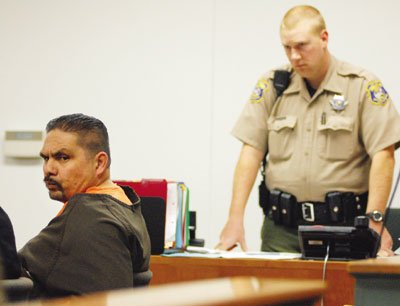From the national housing crisis to the death of Val Filice,
Gilroyans saw plenty happen in 2007. And much more will continue to
happen next year when City Administrator Jay Baksa retires the
first week of January just before the council holds its semi-annual
policy summit and appoints a new police chief.
chris bone – staff writer
cb***@************ch.com
GILROY
From the national housing crisis to the death of Val Filice, Gilroyans saw plenty happen in 2007. And much more will continue to happen next year when City Administrator Jay Baksa retires the first week of January just before the council holds its semi-annual policy summit and appoints a new police chief. Meanwhile, the Gilroy Unified School District continues to struggle with the costs of Gilroy’s second high school, and the city is working against time on a deal to purchase Gilroy Gardens before wealthy developers have an opportunity to do so.
Housing/credit crunch hits Gilroy
Only 750 households in Santa Clara County were sold in November, according to DataQuick Information Systems. That is down about 42 percent from November 2006.
While it seems like the low number of homes sold – the lowest since February 1995 – would imply a drop in prices, as well, that is not the case. The median price of those 750 houses rose 9.5 percent since last year, to $799,000.
Real estate experts say it is mainly because the few homes that found buyers were rather pricey. There has been a rapid decline in the number of lower-priced houses sold in the county, partly because fewer people can qualify for loans and overall demand has fallen.
At least for the first part of 2008, residents will likely experience more of the same.
Secret retirements
Controversy emerged in February when Gilroy Police Department Chief Gregg Giusiana and Assistant Chief Lanny Brown brokered secret retirement deals with Baksa. City council members, police officers and the community were left in the dark about the deals, which allowed the top two law enforcement officers to “double dip” by collecting state retirement pay in addition to a city salary.
Brown resigned April 10 after learning the once-secret double-dipping scheme approved by Baksa violated state pension regulations. Before Giusiana, former chief Roy Sumisaki left under a cloud, and Baksa’s experimental effort to bridge the police and fire commands with Fire Chief Art Gillespie, who became the public safety director, was abandoned.
The city council is expected to pick the next chief Jan. 22, and The Dispatch learned earlier this month that two of the three finalists competing to replace Giusiana are a woman and a black man. If the city council selects either of them, it would a first for the department’s highest seat.
Barsi killer gets 32 years
David Vincent Reyes killed former Garlic Queen and mother Franca Barsi in September 2006. He struck a deal with the prosecution Oct. 5 to serve 32 years and four months in a state prison.
Reyes, 41, pleaded guilty to voluntary manslaughter with a calm, measured tone two months ago, more than a year after Barsi’s Sept. 12, 2006 murder in her Westwood Drive condominium. Authorities found her suffocated, tied with her arms and legs behind her back with a white electrical cord, according to the county medical examiner.
Police pursued Reyes from San Jose to Gilroy and back again before capturing and arresting him two days after Barsi’s death.
Deborah Flores hired
In May the Gilroy Unified School District board of trustees unanimously voted to make Deborah Flores the top employee at the district. She has seven years of experience as a superintendent and more than 15 years as a district administrator and has promised to spend the next seven to 10 years as superintendent.
Flores, who earns $187,500 plus benefits, faced challenges in her professional past similar to those Gilroy will take on in the coming years. She oversaw the building of an elementary school in Lucia Mar and redrew its school boundaries. Gilroy will start construction on a new high school soon and will have to redraw high school boundaries by its planned August 2009 opening.
In Santa Barbara, she helped spur drastic improvements from populations that traditionally score low on standardized tests, such as students of Hispanic descent or low socioeconomic classes. Of Gilroy’s 10,000 students, 68 percent are Latino and 51 percent receive lunch free or at a reduced price and both groups are not meeting state testing expectations.
Election changes council dynamics
Voters gave two city council incumbents the boot in November and filled the three available council seats with attorney Perry Woodward, former councilman Bob Dillon and Parks and Recreation Commissioner Cat Tucker. Councilmen Roland Velasco and Russ Valiquette, and Planning Commission Chairman Tim Day, lost their bids.
Woodward garnered 22 percent of the vote, while Tucker took second with 19 percent and Dillon third with 18 percent. Many voters at the polls described a desire to re-energize the council while letting Mayor Al Pinheiro continue on his promises to beautify downtown and oversee everything from the city’s potential acquisition of Gilroy Gardens to its next sidewalk repair plan.
The three victors specifically pointed to voter dissatisfaction with a controversial salary program for the city’s top 42 employees and a proposed ordinance that would make homeowners more liable for injuries sustained on sidewalks outside their houses.
“People wanted change, and they saw me and the others as people who can bring about that change,” Tucker said.
One thing Tucker took to heart throughout the campaign was the city’s reliance on retail sales tax. Though she and Dillon agreed on preserving open space in the form of Gilroy Gardens, Tucker was the only candidate with a no-compromise stance against the proposed Westfield Mall project east of Gilroy.
Cost increase for second high school/impact fee Battle
City and school district officials gathered at the corner of West Day Road and Santa Teresa Boulevard to break ground on the new Christopher High School in November. The school will accommodate the city growing population with a capacity of 1,800 students.
The project’s total cost is estimated at $110 million, according to district documents that show each square foot will cost $391 to build. Steel prices have increased more than 50 percent since estimates were projected in June, but the gap between available funds and project cost still hovers around $15 million.
Funding for the project comes from a combination of developer fees, state funds, $6.6 million in joint-use funds from the city of Gilroy, land donated by the school’s namesake, Don Christopher, and revenue from the sale of district property.
Developers and district officials have squabbled over the amount of money the school district should receive to compensate for residential projects. Some developers have pledged the maximum amount of so-called “impact fees,” but the issue of money never seems to leave the district alone.
City looks to buy Gilroy Gardens
The city will likely take out a 20-year loan to purchase Gilroy Gardens in February 2008 for about $13.1 million and then lease the operations of the park back to the park’s nonprofit board of directors at a discounted rate.
Baksa has said the city has money in the bank for the potential arts center and library and planned to repay the $13.1 million loan by borrowing about $20 million over 20 years from city funds dedicated to storm drains, sewer projects, city fleets, equipment and possibly gas tax and water funds.
The 536-acre park of mostly open space is valued at closer to $60 million, but the park’s board of directors offered to sell it to the city at a discounted rate in the fall of 2006.
Councilmen Woodward and Craig Gartman constitute a sub committee that is reviewing the tentative purchase and lease agreements along with city officials. This came after Woodward told the council he wanted more access to the private documents after the city attorney denied him access to the drafts.
Mayor Al Pinheiro has maintained that city employees should be allowed to do their job and compose the contract without meddling from the council, which will ultimately approve or deny the agreement.
Westfield looks to build
A few council members and concerned environmentalists have winced at the thought of the world’s biggest owner of shopping malls coming to Gilroy, but others see it as an opportunity for the city to draw more people and jobs to the city.
The Westfield Group wants to build a 1.5-million-square-foot mega mall on 109 of 681 acres east of the Gilroy Premium Outlets. In the hopes of doing this, the Australian-based, multi-billion-dollar company has already begun to pay about $1 million to fast-track its project by paying city planners to work on it and by helping the city create the task force and conduct environmental reports.
These steps are necessary for the city to amend its long-term general plan, re-zone part of the area for the mall and expand its boundaries as part of an indefinite multi-step process that could stretch through 2010.
Councilman Peter Arellano has said he does not like the idea of an enormous mall-cinema-restaurant-hotel-office combo taking business away from other big box retailers such as Kohl’s and from the city’s downtown businesses. Tucker has flatly opposed the entire project, but Pinheiro has reminded the council that Westfield has an opportunity to apply with the city just like anyone else.
“It boils down to this council at some point and time making a decision,” Pinheiro said.
Best of the best salary policy
The council revised the pay structure for the city’s 42 higher-ranking, non-union employees who range from Gilroy’s budget analyst to its police chief.
Councilman Gartman was the lone dissenter in April when the council approved a plan calling for top city managers to earn 15 percent more than those they supervise and 10 percent more than comparable positions in surrounding cities. The decision came after some Gilroy police sergeants started earning as much as their captains because they can negotiate raises as members of a union and also work overtime, whereas chiefs and captains can do neither.
“The exempt group was getting smaller raises than everybody else, and how are you going to recruit a manager when you can get more money staying in a job that requires less responsibility?” asked Councilman Dion Bracco at the time. “Sometimes you have to put aside what the public has to say … We’re elected to make tough decisions.”
While top city officials will not necessarily reap the highest union negotiations, Baksa said they can rest assured that their 15 percent comfort zone will remain. Baksa and Pinheiro contend that the shrinking salary gulf has left managerial positions empty at the engineering and fire departments, and Pinheiro characterized the boss-subordinate gap as the only fair way for all city employees to shoulder the budget deficit.
Festival co-founder Val Filice dies
Every seat at St. Mary Church was filled Nov. 8 with someone whose life and heart had been touched by Val Filice. The “Godfather of Garlic” died of cancer Nov. 4.
Born in Gilroy June 4, 1927, to Angelina and Antonio Filice, Val Filice grew up the son of a farmer and later took on the career. He had two children, Valerie and Bob, with wife Elsie, who died a decade ago.
He became an active volunteer in his spare time, whipping up holiday meals at St. Joseph’s Family Center every year to feed hundreds of homeless, volunteering at the annual spaghetti dinner to benefit St. Mary School athletes, and fueling Gourmet Alley at the Gilroy Garlic Festival, which he co-founded 30 years ago.
During the last few weeks, his door was always open, not a meal was left uncooked, and the house was filled with food and friends, his daughter Valerie Filice said. “He was the best advertising Gilroy had,” she said.














